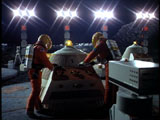
Episode Guide: Year One
Title: "Breakaway"
Within this page: Overview | Backplot | Plot Synopsis | Unanswered Questions | Analyses/Observations | Comments | Memorable Lines
Overview
In the year 1999, the 311 inhabitants of Moonbase Alpha are stranded when the Moon is hurled from Earth's orbit when nuclear waste is ignited by magnetic radiation.
Production Number: 001 (Season One)
- filmed Monday, December 3 - Friday, December 21, 1973; Thursday, December 27 - Friday, December 28, 1973; Wednesday, January 2 - Friday, January 11, 1974; and Friday, February 22 - Tuesday, February 26, 1974
Original U.K. airing week: 4 September 1975 (ATV Midlands)
Original U.S. airing week: 17 October 1975 (syndication)
Written by George Bellak (uncredited: Christopher Penfold)
Directed by Lee Katzin
Backplot
- Since the 1960s, manned and unmanned spaceflights from Earth intensified year after year. Various space programs have yielded interplanetary probes, space stations, a permanent lunar base and manned missions.
- The International Lunar Commission is responsible for Moonbase Alpha, a permanent settlement on Earth's moon, with over 311 inhabitants.
- Commander Gorski is Moonbase Alpha's current commander. He is the eighth commander of the base since it went online.
- The Eagle is the workhorse of Alpha. It is a modular spacecraft, capable of traversing between Earth and the Moon.
- Signals are being received from planet Meta. Earth is preparing a manned mission to the planet, via the Meta probe, which is stationed at the Spacedock above the Moon. (The Spacedock had been also used to launch the Ultra probe.)
- A war occured on Earth in 1987 with nuclear weapons.
- A space station around Venus was infected with an unknown disease and forced to be permanently quarantined. All hands were lost.
- Nuclear waste is being disposed on the "dark side" of the Moon. Nuclear waste is humankind's biggest problem.
- Astronauts for the Meta mission have been training on the Moon, notably near the nuclear waste dumps. These astronauts have been dying, due to mysterious causes.
- Additional pressure from space agencies, due to continued funding from an upcoming International Lunar Finance Committee Meeting, deem that the Meta mission isn't delayed. Commander John Koenig is dispatched to get the Meta mission back on track -- and solve the mystery of the Meta astronauts' illness.
- Future episodes will reveal a number of lost manned and unmanned probe missions. The success of the Meta probe was probably extraordinarily critical to future space missions.
Plot Synopsis
(From the original ITC Press Release.)
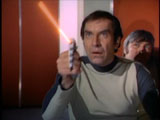 |
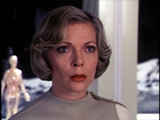 |
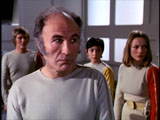 |
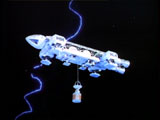 |
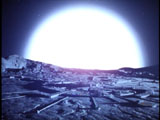 |
View additional images |
Suspected radiation from nuclear waste containers provides (sic) a deep space probe from Earth's space research centre on the Moon. It is a prologue to disaster and mankind's most fantastic adventure.
Preparations are well advanced for the most important space journey in the history of man: a probe into deep space to explore the rogue planet Meta which has broken away from a distant galaxy and is now closer to Earth's solar system. Already, identifiable signals have come from the planet, indicating a high form of life.
John Koenig (MARTIN LANDAU) is commander of the mission to be launched from Earth's Space Research Centre at Moonbase Alpha. He has just returned to the Moon to oversee the momentous adventure, but the probe is already in jeopardy. Two of the deep space astronauts have been stricken with a mystery illness which has already claimed nine lives. All, but the astronauts, have been working at the Nuclear Disposal Area Two on the dark side of the Moon to which nuclear waste from Earth has been consigned.
Dr. Helena Russell (BARBARA BAIN) is convinced that radiation has caused the terrible brain damage to the victims. But evidence discounts her theories. There is no trace of a leakage either from the deeply buried old containers at Disposal Area One or at the new area. Koenig is sure Helena is misdiagnosing. So are others. And scientist, Professor Bergman (BARRY MORSE) confirms that there is no radiation. Koenig checks for himself. Everything is normal - except for intense heat in Koenig's inspection craft.
The two astronauts die. But of what? New facts emerge when their flight recorder tapes are examined and show that everything went black for two minutes while flying over the Disposal Areas, which leads to the discovery that the disused Disposal Area waste had been subject to a magnetic subsurface firestorm. It seems that the same thing may be happening to Disposal Area Two. It is the increased magnetic output that has caused the deaths, and there is immediate disaster when efforts are made to check on Area Two. A blinding nuclear explosion rocks the moon. Gravity control is affected. The Moon -- with Moonbase Alpha -- is pulled out of orbit, moving inexorably away from Earth.
Koenig has to decide whether or not to abandon and makes his grim decision. Their only hope is to remain where they are. To abort would be certain suicide. By now, the Moon is speeding even more rapidly away from Earth. And on Earth, the gravity disruption is causing devastation.
At Moonbase Alpha, the unmistakable sound of Meta signals comes in, now quite loud and clear...
SCREENPLAY BY GEORGE BELLAK
DIRECTED BY LEE KATZIN
Guest Artist
ROY DOTRICE
with
PRENTIS HANCOCK as PAUL MORROW
ZIENIA MERTON as SANDRA BENES
ANTON PHILLIPS as DR. MATHIAS
NICK TATE as ALAN CARTER
PHILIP MADOC as COMMANDER GORSKI
LON SATTON as OUMA
ERIC CARTE as COLLINS
Unanswered Questions
- Moonbase Alpha (MBA) is a permanent, self-sustaining lunar base. Yet, various supplies from Earth were probably needed. How well-stocked was MBA when "Breakaway" occured?
- How could Nuclear Disposal Area #2's destruction have truly knocked the Moon from Earth orbit, out of the solar system and into interstellar space?
- How many Eagles (and pilots) were lost when Nuclear Disposal Area #2 exploded?
- How was Alan Carter's Eagle able to maintain orbit with the runaway Moon as it shifted quickly from Earth's orbit? The Moon lacks a strong magnetic field.
- Why didn't Alan Carter head back to Earth instead of following the Moon?
- Was a Mysterious Unknown Force (M.U.F.) responsible for any of this, including sending the Moon from Earth's orbit and into "an odyssey without end" (as spoken by Arra in a later episode, "Collision Course").
- How many other nuclear disposal sites exist on the Moon?
Analyses/Observations
- During the opening act, Steiner's space helmet visor flys open during his tussel with Nordstrom. (This occurs again within later episodes.)
- Nuclear Disposal Area #2 is fenced with lasers, yet Nuclear Disposal Area #1 isn't. Is there a specific reason for this? Was sabotage ever suspected (pre-"Breakaway", unrelated to the events of "Breakaway"), or the catalyst for adding the fencing?
- The term "Dark Side of the Moon" in the opening scene isn't correct; it should be stated as "Far Side of the Moon." The Moon does receive direct light from the Sun on it's backside (not visible to Earth) during periods of it's orbit.
Comments
- Original U.K. Airdate: Thursday, 4 September 1975 (ATV Midlands); Original U.S. Airdate: 17 October 1975.
- Original Titles for "Breakaway": "Zero G", "The Void Ahead", and "Turning Point."
- The credited writer of "Breakaway" is George Bellak. He was initially hired as a script editor, but left the production upon completion of the script. (It is said he did not get along with Gerry Anderson.) Story Consultant Christopher Penfold then completely rewrote Bellak's script. The original Bellak version, titled "The Void Ahead" was a ninety minute version. Though essentially the same story, many of the supporting characters had yet to finalized; there were also a number of additional scenes which filled in character detail, most notably a sequence where Commander Anton Gorski visits with Commander John Koenig to seriously downplay Dr. Helena Russell's theories about the Meta probe astronauts' "infection"; and a scene where Dr. Russell explains the reason for Gorski's animosity: that he made a pass at her which she didn't reciprocate.
- Both Christopher Penfold and George Bellak appeared together at the MainMission: 2000 event for a panel session to discuss "Breakaway."
- John Koenig had been stationed on Moonbase Alpha before. Both Koenig and Professor Victor Bergman also previously knew one another. (See "Dragon's Domain.") When Koenig enters Main Mission for the first time, many of the personnel are visibly happy to see his return. Koenig appears to command loyalty, respect and affinity from many Alphans. These attributes establish his unquestioned authority when the Moon is blasted from orbit -- and the command chain is opened for compromise. (Example: Telling the Alphans they cannot attempt a return to Earth following the nuclear explosions -- and keeping in mind Koenig has only been in command of the base for four days! No mutiny, nor any disregard for his command authority is seen.)
- Space: 1999 fan Matt Butts wrote a brilliant sequel episode script titled "Breakaway, Part II" which captures the essence of the Year One series... and explains what happened to the Alphans as the Moon leaves the Sol solar system for interstellar space, including numerous inferences to plot elements which are developed in later episodes, plus plot items which were never explored. The story also sets the stage for Commissioner Gerald Simmonds's mutinous mindset in the forthcoming episode, "Earthbound."
- Filming for "Breakaway" began Monday, 5 November 1973 with Brian Johnson and Nick Allder's special effects work at Bray Studios. Principle photography began on "L" and "M" stages at Pinewood Studios on Monday, 3 December 1973. The production continued for six weeks (four weeks longer than scheduled) with an additional three filming days in late February 1974 (at the end of shooting for "Black Sun" to complete the episode. This was primarily due to director Lee H. Katzin's insistence on filming each scene in the minutest detail, shooting scenes over and over again to capture reaction shots of each member of the cast. Originally contracted for the whole series, Katzin only directed one other episode ("Black Sun") before he was "let go." Katzin has previously worked with Martin Landau and Barbara Bain on Mission: Impossible.
- Lon Satton (technician Benjamin Ouma) was originally intended as a series regular, but other Space: 1999 cast members found him difficult to work with. He was not re-contracted for further episodes.
- The regular cast was established in "Breakaway" as Commander John Koenig, Dr. Helena Russell, Professor Victor Bergman, Controller Paul Morrow, Eagle pilot Captain Alan Carter, Sandra Benes, Dr. Bob Mathias, and Tanya Alexander. David Kano (Clifton Jones) replaced the Benjamin Ouma character in "A Matter of Life and Death." Ouma's departure was not officially explained.
- Production of the series began in 1973, but the first episode wasn't broadcast until 1975.
- Originally conceived as a new season of U.F.O. (1970). The plot would have had the aliens (from that series) attempting to destroy S.H.A.D.O.'s moonbase by knocking the moon out of orbit.
- In it's day, Space: 1999 was the most expensive series ever produced for British TV or for syndication.
- From the Sylvia Anderson interview on
http://www.net-gate.com/~simon/sylvia-anderson-interview.html."We were interviewing lots of actors to play the leads when we got a call from Lew Grade saying we really needed someone that was very well known, like 'MISSION IMPOSSIBLE' people. I wanted Robert Culp. We met him. He was quite outrageous, but he would have given the series a very interesting angle. He would not have been the stereotyped hero; he would have been scared at times, he would have made the wrong decisions. But we had to cast Barbara Bain and Martin Landau, whom I freely admit I did not want. I battled very hard and stood up to Lew Grade and said "I don't think they're right. They were okay in 'MISSION IMPOSSIBLE', but having seen them, I don't think we're going to get what we should get." But he said that they were very popular in 'MISSION IMPOSSIBLE', and that they were a good commercial bet, and that was that."The person that was going to buy it for the network left the network, so all the casting was really in vain. It was through him that we did it, and Lew Grade quite rightly had to go by that. But by the time we'd finished the first episode the man had gone and the people coming in didn't want to inherit his decisions. So we actually had Martin Landau and Barbara Bain for no reason. I mean, I'm not saying they were bad, I just think they could have been so much better."
And from story editor/writer Johnny Byrne on Gerry Anderson's involvement with stories:
"One mustn't rule Gerry out of the equation 'coz he was there behind all these stories. Gerry's hard and fast in the sense that his brilliance is the technical side but when you come to story terms, Gerry has very simple ideas and all the better they are for it. If one was to qualify this effect: Gerry could make a good script infinitely better and make a bad script very much worse. And I think he'd smile and nod and say truthfully 'Yeah. Perhaps' if I said it to him. He would go for the basic virtues and he was all for, you know, people expressing their emotion."
- In a SciFi.com "Science Fiction Weekly" interview, Gerry Anderson was asked the relevance of "Breakaway's" September 13th date:
Q: Any particular significance to the date of September 13, 1999, as the starting point for when the moon blasts out of Earth orbit?
Anderson: Thirteen is an unlucky number and I had 12 choices for the month and chose September.
Memorable Lines
"Now we're sitting on the biggest bomb man's ever made." - John Koenig
Copyright 1999-2003 www.Space1999.org. All Rights Reserved. Legal
notice.
This work is licensed under a Creative
Commons License, in conjunction with our Open
Source Content Model. This site uses XHTML and CSS and looks best with
a standards compliant
browser.





